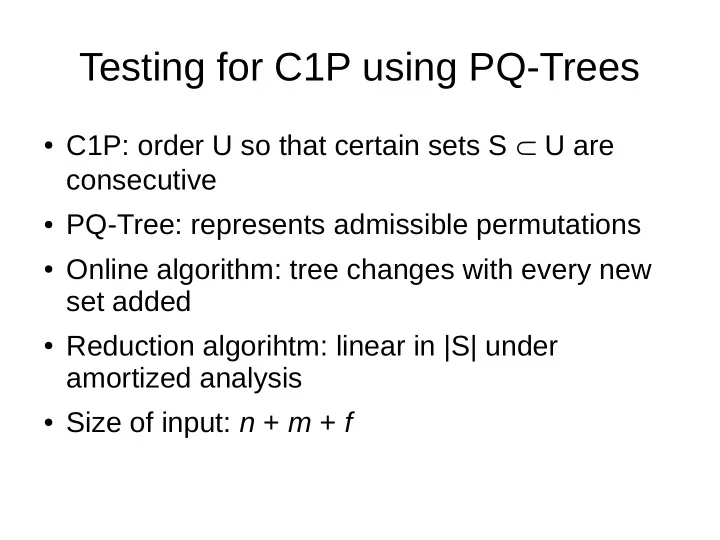

Testing for C1P using PQ-Trees ● C1P: order U so that certain sets S ⊂ U are consecutive ● PQ-Tree: represents admissible permutations ● Online algorithm: tree changes with every new set added ● Reduction algorihtm: linear in |S| under amortized analysis ● Size of input: n + m + f
PQ-Trees ● Universal set U ● Leaves: elements of U ● Internal nodes: – P nodes T 1 T 2 … T k – Q nodes T 1 T 2 … T k
Proper PQ-Trees ● Every element of U appears exactly once as a leaf ● Every P node has at least 2 childern ● Every Q Node has at least 3 children Frontier ● Reading the leaves from left to right
Equivalent trees ● Notation: T 1 = T 2 ● T 1 and T 2 are equivalent when one can be transformed into the other by zero or more equivalence transformations: – arbitrarily permute the children of a P node – reverse the children of a Q node CONSISTENT(T) = {FRONTIER(T') | T' = T}
Universal tree and null tree ● Universal tree: |U| = m a 1 a 2 … a m ● Null tree = ∅ CONSISTENT( ∅ ) = ∅
Modern implementation PQTree<E> PQNode<E> universalSet: set of <E> parent: PQNode<E> root: PQNode<E> childList: list of -------------------------------------- <PQNode> proper(): boolean type: Enum(P,Q,L) frontier(): list of <E> ------------------------------- equivalent(PQTree<E>): boolean consistent(): set of <list of <E>> isUniversal(): boolean reduce(set of <E>)
Reducing PQ-trees ● Input: PQ-tree T, set S ⊆ U ● Bottom-up: starts at leaves; process each node only after all its children have been processed ● Processing each node: – Find a pattern that applies to it – Replace the pattern by the replacement ● Stop when: – No pattern for a node: return null tree – After processing a node that “contains” S
Modern implementation (2) PQTree<E> PQNode<E> universalSet: set of <E> parent: PQNode<E> root: PQNode<E> childList: list of -------------------------------------- <PQNode> proper(): boolean type: Enum(P,Q,L) frontier(): list of <E> ------------------------------- equivalent(PQTree<E>): fjndPattern(): Pattern boolean apply(Pattern) consistent(): set of contains(set of <E>): <list of <E>> boolean isUniversal(): boolean reduce(set of <E>)
Processing a node with respect to S ● Full, empty, partial full empty partial ● Pertinent: full or partial ● Pertinent subtree: contains S ● ROOT(T,S): lowest node whose frontier contains S
Modern implementation (3) PQTree<E> PQNode<E> universalSet: set of <E> parent: PQNode<E> root: PQNode<E> childList: list of -------------------------------------- <PQNode> proper(): boolean type: Enum(P,Q,L) frontier(): list of <E> ------------------------------- equivalent(PQTree<E>): fjndPattern(): Pattern boolean apply(Pattern) consistent(): set of contains(set of <E>): <list of <E>> boolean isUniversal(): boolean frontier(): list of <E> reduce(set of <E>) root(set of <E>): PQNode<E>
Templates: pattern and replacement ● Goal: after replacement, the frontier of the subtree rooted at this node, as well as all equivalent subtrees, have all their pertinent leaves consecutive ● Affects node and its children only ● Type of node and label of children (full, empty, partial) matter ● Types of children do not matter any type
Templates for leaves ● Just label as empty or full
Templates for P-nodes Pattern Replacement ... ... ... ...
Templates for P-nodes (cont.) ● Templates when some children are empty and some full – Depend on node being ROOT(T,S) or not – If node is not ROOT(T,S), creates a partial P-node ● Templates when there are partial children – One or two partial children ok – More than two partial children: no pattern ● All templates: apply to equivalent nodes as well
Templates for Q-nodes ● Templates for all children empty or all children full ● Templates for some children empty and some full ● Depend on node being ROOT(T,S) or not ● Templates for partial children – One or two partial children ok – More than two partial children: no pattern ● All templates: apply to equivalent nodes as well
Efficient implementation ● Need to avoid empty subtrees to guarantee amortized |S| time ● Prunned pertinent subtree ● Two bottom-up phases – Bubbling up: identifying prunned pertinent nodes – Reduce: reducing prunned pertinent nodes ● Problem with parent pointers: blocking ● NORM(T): potential for amortized analysis
Recommend
More recommend